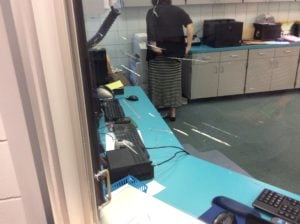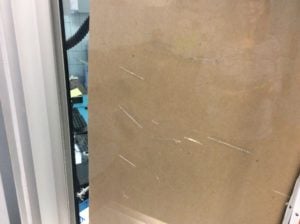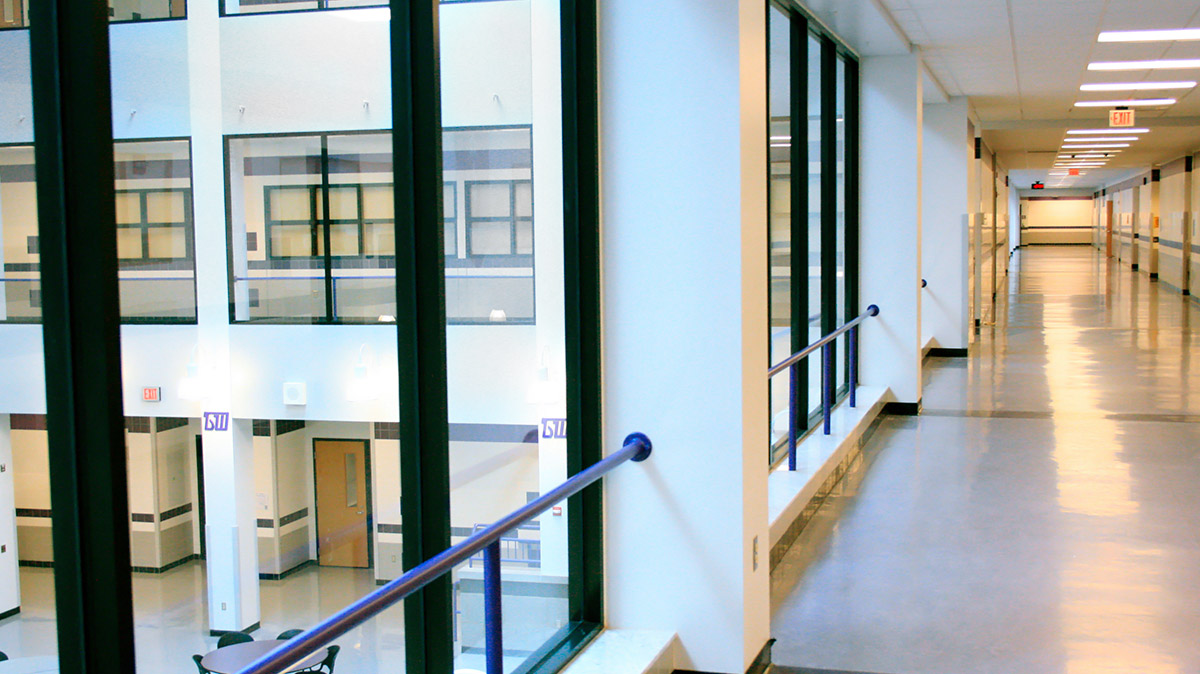Total Security Solutions Senior Sales Consultant Bob George recently received these photos from a school in Florida, showing the condition of their security windows.


What happened to these windows? Most people assume that this glass is decades old and deeply scratched. Maybe someone gouged it with a screwdriver or hacked at it with a machete?
But none of that is the case. This glass is just a few years old, and those aren’t scratches or cracks. If you could touch this glass, you’d find that these marks cannot be felt on the surface.
These security windows weren’t damaged by a knife or machete; this damage was done with plain-old glass cleaner.
According to Jim Richards, CEO of Total Security Solutions, there is one remarkably expensive misconception about school security windows:
“People use the word ‘bulletproof’ to mean ‘indestructible’ or ‘totally fool-proof.’ But with real bullet-resistant materials, it’s almost the opposite: Because they are so optimized to stop bullets, they are susceptible to things that plain-old window glazing shrugs off. Every year, we see more security windows damaged by cleaners than by bullets.”
Schools seem especially hard-hit by such cleaning catastrophes.
Glass vs. Acrylic and Polycarbonate
Glass, acrylic, and polycarbonate (alone and in laminated combinations) are all used in security windows and bullet-resistant barriers. To the casual observer, these materials can be indistinguishable. But they all behave very differently.
Glass may be brittle, but it’s exceptionally hard. It withstands a lot of rubbing, scraping, and scuffing without getting marked up. Glass is also notoriously impermeable and chemically inert. Not much interacts with it—which is why glass is used to store many hazardous chemicals, despite the possibility of a fumbled bottle breaking. Glass can sit out in the elements for decades, even centuries, and remain crystal clear. Think of the windows on old buildings, or the ancient Roman glass displayed in museums: they’re as clear today as the day they were made—provided they haven’t been smashed.
Acrylic and polycarbonate—the most popular materials for bullet-resistant glazing and security windows—are almost the opposite. They are much stronger than glass, but not nearly as hard. As a result, they’re prone to scuffs and scratches. But, given the material’s overall strength scratches usually aren’t a big deal. Scratches in acrylic can be easily buffed out (sometimes with nothing more than toothpaste and determination). But thermoplastics like acrylic and polycarbonate are also somewhat porous. This leaves them susceptible to chemical contact and is the root of what happened to those school security windows shown above.
Security Windows and “Crazing”
The marks you see in the acrylic security windows shown above aren’t surface scratches. These are especially extreme forms of “crazing.” When bulletproof polycarbonate and acrylic are cut, drilled, or flame-polish, microscopic fractures form in the plastic. These are not usually visible to the naked eye and have no impact on the material’s strength or durability.
“But,” Jim explains, “cleaners that contain things like alcohol or ammonia can penetrate the surface of the glazing and attack the edges of those invisible fractures.” This changes the optics of the material, making the crazing visible, “It will look like there are cracks going into the glass.”
It’s very important to remember that visible crazing—even as extreme as what you see in the images above—has no impact on the material’s bullet resistance. In fact, in these particular materials, crazing can indicate areas of increased strength.
But it looks absolutely terrible.
You can buff out surface scratches in polycarbonate or acrylic. But crazing creates a haze that penetrates the material. According to Jim, “When it’s done, it’s done”; there is no practical way to remove crazing. The only option is to replace the bullet-resistant security windows.
New Craze-free Security Window Glass
“Most conventional bullet-resistant window transparencies can craze if improperly cleaned,” Bob George notes. “And improper cleaning happens often—especially in schools. These pictures show a ‘worst-case scenario’ of what happens when acrylic is cleaned improperly over a period of time. This product is only five years old! I’ve seen crazing, before but nothing this extreme.”
Even though TSS makes a point of coaching every customer in the proper care of bullet-resistant security windows, these cleaning mistakes—which can easily cost thousands of dollars per window—are still too common. That’s especially true in big organizations, like schools, where maintenance crews are large, turnover can be high, and there are many rotating responsibilities across several locations.
This is why TSS is so pleased to be introducing their new DEFENDER Ballistic Insulated Glass. This is an insulated, indoor/outdoor “vandalism-resistant” security window glazing that has been tested to UL bullet-resistance standards and demonstrated forced-entry resistance.
Instead of relying on thermoplastics (as with traditional bullet-resistant windows), DEFENDER is an all-glass security window glazing. It’s built around layers of tempered glass, specially annealed and laminated to make them harder and stronger, while retaining glass’s impermeability and chemically inert qualities. You can use any window cleaner on this glass. There is no risk of crazing, hazing, or de-lamination—although we still advise schools to stick to mild soap or vinegar/water mixes; these are both easier on building materials in general and safer around children.
Multi-Function Security Windows Robust Enough for Schools
“This is an all-around performance security window glazing,” Jim says. “In contrast to traditional security glazings, which are optimized to meet one specific security goal, this is more of a Swiss Army Knife, good in many situations. It’s the first time we’ve been able to make something like this available, a security window material that really is suited to everything that goes on at a school, all the ways those buildings are used, and all the ways they could become vulnerable—both in an extreme situation and on a daily basis.”



